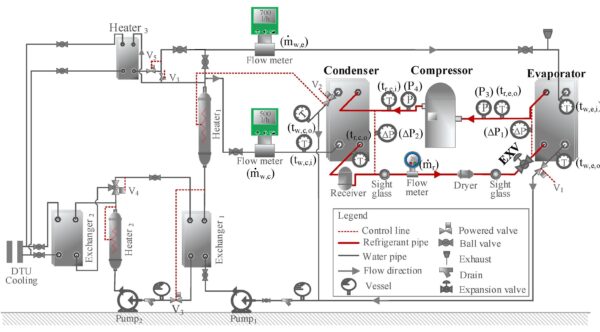An international research group has investigated the performance of booster heat pumps (BHPs) in ultra-low temperature district heating (ULTHD) networks and has found that the refrigerant charge is a key factor in determining the feasibility of such a hybrid system configuration.
BHPs are used in DH systems to make them operate at substantially lower temperature levels, improving the coefficient of performance of central heat pumps used in the networks themselves, while simultaneously lowering DH grid losses significantly. They also help reduce heat loss along the DH system.
In the study “Integration of booster heat pumps in ultra-low temperature district heating network: Prototype demonstration and refrigerant charge investigation,” published in Energy and Buildings, the scientists explained that their assessment was based on 212 relevant papers published up to and including 2022 and said they found a significant lack of data on the influence of the refrigerant charge in BHPs operating in DH networks.
They also stressed that the refrigerant charge plays a crucial role in optimizing the BHP operation, as an insufficient charge may lead to an underutilized evaporator. “In ultra-low temperature district heating systems, the COP of the booster heat pump is significantly affected by the district heating return temperature when the temperature of the domestic hot water is fixed (e.g., 60 C),” they emphasized. “It is recommended to regulate the booster heat pump operation to a higher evaporator outlet water temperature within the allowable range of district heating return temperature.”
In the researched setup, a household’s water tank for domestic hot water acts as a sink for the BHP, while district heating is used as the heat source. The scientists proposed to use R134a as the refrigerant for the configuration. Their analysis considered varying refrigerant charge, heat sink, and source temperatures.

Image: Technical University of Denmark, Energy and Buildings, Creative Commons License CC BY 4.0
They found that a refrigerant charge of 4.6 kg is the most coefficient fluid quantity for the proposed system configuration, which they said may achieve a coefficient of performance (COP) value of 4.95.
“However, it is worth noting that at a higher refrigerant charge of 4.8 kg, the COP starts to decline slightly due to a slight overcharge, while the optimal heating capacity is achieved at this point,” they added. “Consequently, for this prototype, the optimal refrigerant charge for maximum COP is slightly lower than that for maximum cooling capacity, a trend observed in many air conditioners and household heat pumps.”
The researchers also found that when the inlet temperature is set to 40 C, a lower temperature lift, which is the difference in temperature between the heat source and the heat sink, leads to a higher COP, but a lower exergetic efficiency. “In practical scenarios, there may be a trade-off between energetic and exergetic efficiencies, and a balanced operation could be achieved by optimizing the operating parameters,” the research group further explained.
The scientists concluded by saying that the implementation of BHPs in ULTDHs offers many benefits, including a more efficient integration of renewable energy sources. “However, careful consideration must be given to the design of the system configuration, as various factors such as guaranteed refrigerant rate, time-sensitive parameters, and target temperature for DHW will impact its operation and performance,” they stated.
The research group is formed by scientists from the Technical University of Denmark, the University of Twente in the Netherlands, and Danish technology company Danfoss.
This content is protected by copyright and may not be reused. If you want to cooperate with us and would like to reuse some of our content, please contact: editors@pv-magazine.com.



By submitting this form you agree to pv magazine using your data for the purposes of publishing your comment.
Your personal data will only be disclosed or otherwise transmitted to third parties for the purposes of spam filtering or if this is necessary for technical maintenance of the website. Any other transfer to third parties will not take place unless this is justified on the basis of applicable data protection regulations or if pv magazine is legally obliged to do so.
You may revoke this consent at any time with effect for the future, in which case your personal data will be deleted immediately. Otherwise, your data will be deleted if pv magazine has processed your request or the purpose of data storage is fulfilled.
Further information on data privacy can be found in our Data Protection Policy.